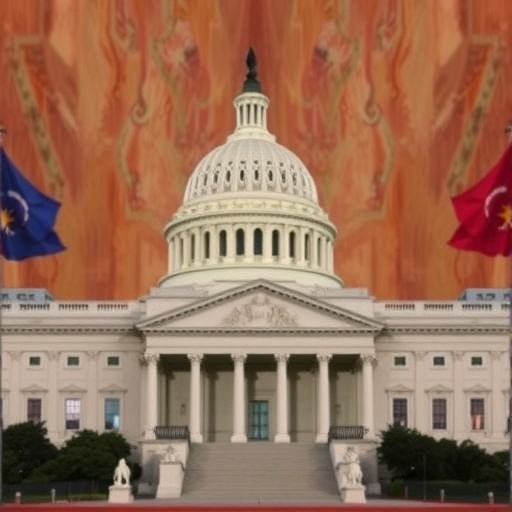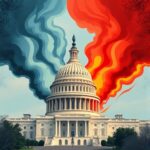Senate Democrats Block GOP Funding Extension, Sparking Prolonged Government Shutdown Crisis
In a dramatic standoff on Capitol Hill, Senate Democrats have decisively blocked a Republican-led proposal to extend government funding through November 21, effectively prolonging the ongoing government shutdown and thrusting millions of federal workers and essential services into deeper uncertainty. This latest impasse, unfolding amid heated partisan debates, underscores the deepening divide between Democrats and Republicans over fiscal priorities, leaving the nation’s economy and public services hanging in the balance.
The Republican Proposal That Hit a Wall
The Republican proposal, spearheaded by Senate Minority Leader Mitch McConnell and backed by a coalition of GOP lawmakers, aimed to provide a short-term extension of current government funding levels. Tabled on the Senate floor late Wednesday, the bill sought to avert an immediate lapse in appropriations by maintaining baseline spending through mid-November. Proponents argued it would buy precious time for negotiations on a more comprehensive budget deal, avoiding the chaos of another shutdown deadline just weeks away.
Key elements of the proposal included a clean continuing resolution (CR) without additional policy riders, focusing solely on sustaining operations for agencies like the Department of Defense, Homeland Security, and veterans’ services. Republicans highlighted data from the Congressional Budget Office (CBO), which estimated that a shutdown could cost the U.S. economy up to $1.5 billion per week in lost productivity. “This is about stability, not surrender,” McConnell stated in a floor speech, emphasizing the urgency as the current funding patch expires at midnight on Friday.
Despite garnering support from all 49 Republican senators and a handful of moderate Democrats, the measure fell short of the 60 votes needed to overcome a filibuster. Senate Majority Leader Chuck Schumer, a Democrat from New York, rallied his caucus to vote against it, citing the bill’s failure to address pressing Democratic priorities such as disaster relief and border security enhancements.
Democrats Dig In: Why the Shutdown Persists
Democrats’ rejection of the Republican funding extension stems from a broader strategy to force concessions on key issues, including immigration reform and increased funding for social programs. In a pointed rebuke, Schumer declared, “We cannot keep kicking the can down the road while American families suffer from inaction on real challenges.” The Democratic stance reflects frustration with what they view as Republican obstructionism, particularly in light of recent natural disasters like Hurricane Ida’s aftermath, which has strained federal resources.
Internal party dynamics played a significant role in the vote. Progressive Democrats, led by figures like Senator Bernie Sanders of Vermont, pushed for amendments that would tie funding to progressive goals, such as expanding child tax credits and investing in green infrastructure. While these amendments were stripped out in committee, the core bill’s passage without them was deemed insufficient. Voting records show a near-unanimous Democratic bloc—50 senators—opposing the measure, with only one defection from a centrist Democrat wary of the shutdown’s economic toll.
Historical context adds weight to this decision. The current shutdown, now entering its third week, echoes the 35-day impasse of 2018-2019, the longest in U.S. history, which cost an estimated $11 billion in back pay and lost output according to the CBO. Democrats argue that repeated short-term fixes exacerbate uncertainty, pointing to a Government Accountability Office (GAO) report that documented over 800,000 federal employees furloughed or working without pay during the last major shutdown.
Economic Ripples: Federal Workers and Businesses Feel the Strain
The prolonged government shutdown is exacting a heavy toll on everyday Americans, with federal workers bearing the brunt. Over 2 million civilian employees across agencies are affected, including 800,000 who are furloughed and another 1.2 million working without guaranteed paychecks. In Washington, D.C., alone, local businesses report a 15% drop in revenue, as seen in data from the U.S. Chamber of Commerce, with restaurants and retailers near federal buildings suffering the most.
Consider the story of Maria Gonzalez, a Smithsonian Institution curator furloughed for two weeks. “We’re rationing groceries and dipping into savings we don’t have,” she shared in an interview with The Washington Post. Her plight mirrors thousands: the Treasury Department’s latest figures indicate that unpaid workers have already forgone $500 million in wages, with projections climbing to $2 billion by month’s end if the shutdown drags on.
Beyond workers, essential services are disrupted. National parks remain partially closed, delaying tourism revenue estimated at $40 million daily by the National Park Service. Air traffic controllers and border agents continue working, but without pay, leading to morale issues and potential safety risks. The FAA has warned of increased flight delays, while Customs and Border Protection reports backlogs in trade processing, costing exporters up to $300 million weekly according to the American Association of Exporters and Importers.
Economists are sounding alarms on broader impacts. Moody’s Analytics predicts a 0.2% shave off fourth-quarter GDP growth if the shutdown extends beyond October, compounding inflation pressures from supply chain woes. Small businesses, reliant on federal contracts, face delays in payments totaling $10 billion, per the Small Business Administration, pushing some toward bankruptcy.
Partisan Blame Game Heats Up in the Senate
The Senate chamber has become a battleground of rhetoric, with Democrats and Republicans trading barbs over the funding fiasco. Republicans accuse Democrats of playing politics with national security, pointing to stalled nominations for military posts and delayed Pentagon contracts. “This shutdown is on the Democrats’ hands—they’re holding the American people hostage,” fumed Senator Ted Cruz of Texas during a press conference, invoking memories of his own role in past shutdowns to rally the base.
Democrats counter that Republicans are dodging accountability on issues like voting rights and climate funding. House Speaker Nancy Pelosi, though not in the Senate, weighed in via Twitter: “GOP’s half-measures won’t cut it. We need real solutions for working families.” Polling from Gallup shows public approval for Congress at a dismal 18%, with 62% blaming both parties equally for the gridlock, though Democrats lead slightly in favorability among independents.
Behind the scenes, negotiations falter. A bipartisan working group, formed last week under the auspices of the Senate Appropriations Committee, proposed a compromise CR with $5 billion in added disaster aid, but it dissolved amid disagreements over immigration language. Senate Parliamentarian Elizabeth MacDonough’s rulings on procedural matters have further complicated passage, ruling certain riders impermissible under budget rules.
Media coverage amplifies the divide. Outlets like Fox News frame it as Democratic overreach, while CNN highlights Republican intransigence on social spending. Social media buzzes with #EndTheShutdown trending, amassing over 500,000 posts, many from affected workers sharing personal stories.
Path Forward: Bipartisan Breakthrough or Escalating Crisis?
As the shutdown enters uncharted territory, eyes turn to potential off-ramps. President Joe Biden has urged swift action, scheduling a White House meeting with congressional leaders for Saturday. In a statement, he warned, “Every day this continues, families pay the price—we must find common ground.” Insiders suggest a slim chance for a revised CR incorporating Democratic demands, such as $10 billion for infrastructure previews, could pass muster.
However, risks loom large. If no deal emerges by next week, the debt ceiling—due to hit in early November—could intersect with the funding crisis, risking default and global market turmoil. Fitch Ratings has placed U.S. debt on negative watch, citing political dysfunction. Labor unions, including the American Federation of Government Employees, plan protests at the Capitol, demanding back pay guarantees.
Looking ahead, this saga could reshape midterm dynamics. Republicans aim to weaponize the shutdown in campaign ads, targeting vulnerable Democrats in red states. Yet, historical precedents suggest public fatigue favors compromise: the 2013 shutdown boosted Democratic turnout in subsequent elections. Analysts from the Brookings Institution forecast that a prolonged impasse might erode trust in institutions, with voter turnout potentially dipping 5% in 2022.
For now, the Senate remains locked in debate, with procedural votes scheduled through the weekend. Whether Democrats and Republicans can bridge their chasm on government funding will determine not just the shutdown’s end, but the trajectory of U.S. governance in a polarized era. As one anonymous Senate aide put it, “This isn’t just about budgets—it’s about who controls the narrative heading into election season.”
The stakes couldn’t be higher, with implications rippling from federal paychecks to international perceptions of American stability. Watch for updates as talks intensify.










